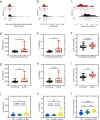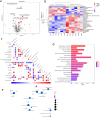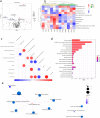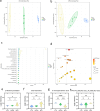Associations between plasma markers and symptoms of anxiety and depression in patients with breast cancer
- PMID: 39394561
- PMCID: PMC11468209
- DOI: 10.1186/s12888-024-06143-x
Associations between plasma markers and symptoms of anxiety and depression in patients with breast cancer
Abstract
Background and purpose: Among patients with solid tumors, those with breast cancer (BC) experience the most severe psychological issues, exhibiting a high global prevalence of depression that negatively impacts prognosis. Depression can be easily missed, and clinical markers for its diagnosis are lacking. Therefore, this study in order to investigate the diagnostic markers for BC patients with depression and anxiety and explore the specific changes of metabolism.
Method and results: Thirty-eight BC patients and thirty-six matched healthy controls were included in the study. The anxiety and depression symptoms of the participants were evaluated by the 17-item Hamilton Depression Scale (HAMD-17) and Hamilton Anxiety Scale (HAMA). Plasma levels of glial fibrillary acidic protein (GFAP) and lipocalin-2 (LCN2) were evaluated using enzyme linked immunosorbent assay, and plasma lactate levels and metabolic characteristics were analyzed.
Conclusion: This study revealed that GFAP and LCN2 may be good diagnostic markers for anxiety or depression in patients with BC and that plasma lactate levels are also a good diagnostic marker for anxiety. In addition, specific changes in metabolism in patients with BC were preliminarily explored.
Keywords: Breast cancer; Diagnosis; Metabolism; Mood; Patients.
© 2024. The Author(s).
Conflict of interest statement
The authors declare no competing interests.
Figures






Similar articles
-
Association of Anxiety and Depressive Symptoms with Thyroid Hormone Concentrations in Patients with Primary Bone Tumors.Endocr Metab Immune Disord Drug Targets. 2024;24(8):902-908. doi: 10.2174/0118715303238500231101051257. Endocr Metab Immune Disord Drug Targets. 2024. PMID: 37937562
-
Gender differences in associations of depressive symptoms and anxiety with inflammatory markers in patients with non-obstructive coronary artery disease.J Psychosom Res. 2019 Oct;125:109779. doi: 10.1016/j.jpsychores.2019.109779. Epub 2019 Jul 17. J Psychosom Res. 2019. PMID: 31421324
-
Prevalence of depression and anxiety in rheumatoid arthritis patients and their associations with serum vitamin D level.Clin Rheumatol. 2018 Jan;37(1):179-184. doi: 10.1007/s10067-017-3874-4. Epub 2017 Oct 23. Clin Rheumatol. 2018. PMID: 29063463
-
Neurofilament light and glial fibrillary acidic protein in mood and anxiety disorders: A systematic review and meta-analysis.Brain Behav Immun. 2025 Jan;123:1091-1102. doi: 10.1016/j.bbi.2024.11.001. Epub 2024 Nov 5. Brain Behav Immun. 2025. PMID: 39510417
-
The Effectiveness of Cognitive Behavioral Therapy on Depression and Anxiety Symptoms in Breast Cancer Patients and Survivors: A Systematic Review of Interventional Studies.Brain Behav. 2024 Oct;14(10):e70098. doi: 10.1002/brb3.70098. Brain Behav. 2024. PMID: 39467209 Free PMC article.
Cited by
-
Early identification and prevention of depressive symptoms in breast cancer patients.World J Clin Oncol. 2025 Jul 24;16(7):106792. doi: 10.5306/wjco.v16.i7.106792. World J Clin Oncol. 2025. PMID: 40741204 Free PMC article.
-
Evaluation of renal function with neutrophil gelatinase-associated lipocalin in patients with ıron deficiency anemia.Sci Rep. 2025 Apr 17;15(1):13217. doi: 10.1038/s41598-025-97888-2. Sci Rep. 2025. PMID: 40240782 Free PMC article.
-
Characteristics of positive and negative effects on the quality of life of breast cancer patients.BMC Psychiatry. 2024 Dec 18;24(1):926. doi: 10.1186/s12888-024-06311-z. BMC Psychiatry. 2024. PMID: 39696113 Free PMC article.
References
-
- Sung H, Ferlay J, Siegel RL, Laversanne M, Soerjomataram I, Jemal A, Bray F. Global cancer statistics 2020: GLOBOCAN estimates of incidence and mortality worldwide for 36 cancers in 185 countries. CA Cancer J Clin. 2021;71(3):209–49. - PubMed
-
- Wang YH, Li JQ, Shi JF, Que JY, Liu JJ, Lappin JM, Leung J, Ravindran AV, Chen WQ, Qiao YL, et al. Depression and anxiety in relation to cancer incidence and mortality: a systematic review and meta-analysis of cohort studies. Mol Psychiatry. 2020;25(7):1487–99. - PubMed
-
- Mitchell AJ, Chan M, Bhatti H, Halton M, Grassi L, Johansen C, Meader N. Prevalence of depression, anxiety, and adjustment disorder in oncological, haematological, and palliative-care settings: a meta-analysis of 94 interview-based studies. Lancet Oncol. 2011;12(2):160–74. - PubMed
-
- Ding X, Wu M, Zhang Y, Liu Y, Han Y, Wang G, Xiao G, Teng F, Wang J, Chen J, et al. The prevalence of depression and suicidal ideation among cancer patients in mainland China and its provinces, 1994–2021: a systematic review and meta-analysis of 201 cross-sectional studies. J Affect Disord. 2023;323:482–9. - PubMed
Publication types
MeSH terms
Substances
Grants and funding
LinkOut - more resources
Full Text Sources
Medical
Miscellaneous

